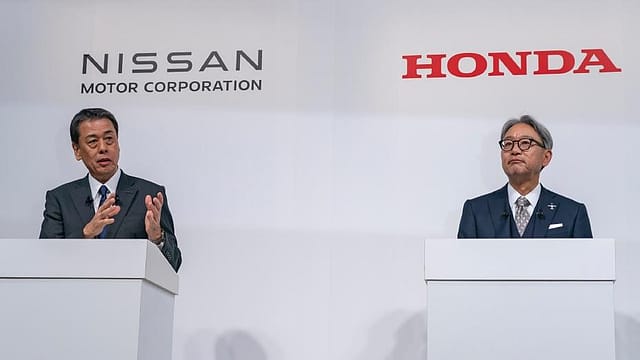Honda-Nissan merger faces high execution risk: Moody’s
ADVERTISEMENT

The proposed merger of Honda Motor Co and Nissan Motor Co to create the world's third-largest automaker by volume faces high execution risk, especially for Honda, which has lower margins in its automotive business compared to its motorcycle business, according to Moody’s.
Honda's operating margin for the automotive business alone was just 4.1% in fiscal 2023, lower than those of similarly rated global auto peers. Honda's automotive business does not have much buffer to absorb Nissan's automotive business operating margin, which was loss-making as of the first half of fiscal 2024, the credit rating agency says, adding that increased costs related to the merger could also weaken Honda's credit profile.
“This gives it less flexibility in absorbing Nissan’s automotive business, which is currently under heavy restructuring and loss-making,” says Moody’s.
On Monday, the two Japanese carmakers signed a memorandum of understanding (MOU) to start merger discussions by forming a joint holding company as they look to maintain global competitiveness amid tough competition from Chinese firms.
Moody’s says the 1.1 trillion Japanese yen buyback announced by Honda for its own shares is credit negative for Honda as it will erode its liquidity or credit metrics depending on the amount of cash or debt it uses to fund the buyback.
The credit rating agency, however, adds that the proposed Honda-Nissan business integration is overall credit positive if executed successfully. “We believe that a larger scale through integration will result in stronger credit quality, particularly for Nissan, which currently has significantly weaker credit metrics than Honda,” it says.
January 2026
Netflix, which has been in India for a decade, has successfully struck a balance between high-class premium content and pricing that attracts a range of customers. Find out how the U.S. streaming giant evolved in India, plus an exclusive interview with CEO Ted Sarandos. Also read about the Best Investments for 2026, and how rising growth and easing inflation will come in handy for finance minister Nirmala Sitharaman as she prepares Budget 2026.
In the financial year ended on March 31, 2024, on a group basis including China volumes, Honda sold 4.1 million units, while Nissan sold 3.4 million units. A combined 7.5 million units would put the integrated company behind the world’s largest and second-largest automakers, Toyota Motor Corporation and Volkswagen, which sold 11.1 million units in fiscal 2023 and 9.2 million units in 2023, respectively, on a group basis. The potential addition of Mitsubishi Motors Corporation, which will make a decision on whether to join Nissan and Honda by the end of January 2025, would increase the combined volume to around 8.5 million units.
Honda and Nissan have significant overlap in their sales regions and the business integration is unlikely to significantly enhance their geographic diversification by sales for automobiles, says Moody’s. “However, in terms of profit and cash flow, Honda's highly profitable motorcycle business will continue to support the combined company. Heavy exposure of Honda's motorcycle business to emerging markets, such as ASEAN and India, will help with cash flow diversification outside of automobiles and developed markets. The new entity would also retain its top share globally in motorcycles through Honda, which sold around 19 million units in fiscal 2023,” it says.
An integration would allow the automakers to share research and development (R&D) costs, supply chain costs and manufacturing plant investment. This will particularly help in the introduction of new electrified powertrain models, such as hybrids, plug-in hybrids and battery electric vehicles. These synergies could help the two automakers pool resources for new model design and manufacturing of vehicles in China, the world's largest automotive market by sales, where both have been struggling to adapt to consumer preferences for new energy vehicles. However, turning around two sizable China operations will entail significant execution risk, says Moody’s.
The integration would be more credit positive for Nissan than for Honda, the rating firm says. “Honda is the stronger credit, reflecting a better track record of stable profit and cash flow, management strategy, and diversification outside of automobiles into motorcycles. Motorcycle margins are significantly higher than those for automobiles. In addition, growth in the motorcycles sector is less correlated to the mature automotive markets that Nissan is dependent on and instead more exposed to fast-growing emerging markets, such as those in ASEAN and India. Motorcycles also face much less threat from electrification,” it says.
